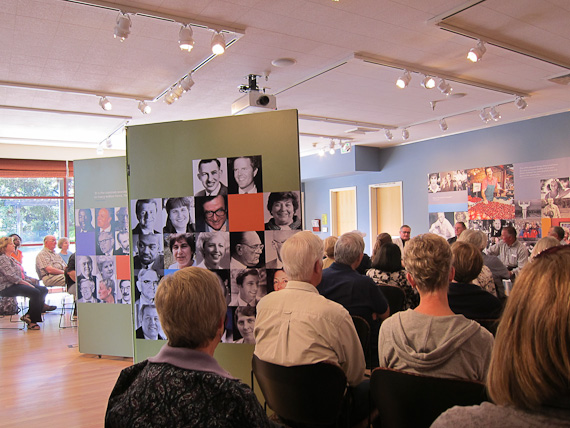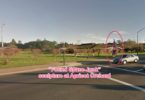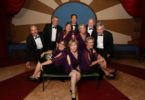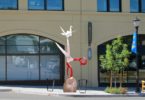Update July 15: Live Video Feed Coming from Satura Cakes
The video feed from downtown to the History Museum will GO LIVE. The plan is to have the camera at Satura Cakes. It will stream live “people-watching” to the History Museum. Cool or what! Fashionistias are checking out the ladies’ shoes! And, thanks to Facebook, self-display is very cool. Ummm. Shoes.
We are correcting the Figure names below as well. Thank you Jane Reed for your help.
Figure 1:
top row: Dana Carlson – Mark Russell (entertainer from D.C.) – Mickie Wheat ( former Foothill Colleague trustee)
middle row: Elaine Daubner – Charlene Geers – Dick Petersen – Dick Wheat ( physician )
bottom row: Jill Lave – Ame Croce (former City Manager ) – Jan Reed ( Former City Mayor )
About the Current Faces Exhibit
Be sure to stop by the Los Altos History Museum and spend a few minutes with the current exhibit, Faces of Los Altos. It’s about life in the fifties Los Altos. It was created by Jane Reed, former Mayor of Los Altos, to commemorate the 60th Anniversary of the city’s incorporation.
Figure 2:
Panelists left to right : Frank White, Bud Chandellor, Mel Kahn, Jimmy Furuichi, George Estill, Jr.
Saturday, June 23 there was a panel discussion featuring five lively, entertaining, story-telling gentlemen who were teenagers in Los Altos in the 50’s. Many reminisced about picking apricots for about a $1 a tray, and about real estate prices in the 40’s and 50’s. Lots on Main and First went for $10. Beginning a long Los Altos tradition of flipping real estate, one entrepreneur bought lots for $10 and sold them for $25. Some of the men went to schools that are now torn down. A majority of the audience seemed to be people who have lived in Los Altos about as long as the panel members. The discussion closed on a “noir” note: one man told a story of the still unsolved knifing murder of a wealthy but frugal neighbor lady who lived alone on Covington right across from the school.
Most of the Faces Exhibit is literally over 100 large photo prints of faces. Giving a nod to technology, photos of faces are sometimes also put into digital picture frames mounted to the wall (I just threw out my collection of energy-consuming digital frames, er, recycled them I mean). Also interesting was a small video display: grainy, black and white surveillance-camera-style, of people walking past the U.S. Bank Building Corner at Main and Second. At first I though it was a live feed, but soon realized it is just short loop.
An Economic History of Incorporation
The movement to incorporate was triggered by the rapid influx of population in the area to work in the nascent electronics industry – at that time it was the military electronics industry at Moffet Field and Lockheed. The electrical engineering research at Stanford also drew employment. To meet the demand for housing, the agricultural land in orchards and berries was being subdivided into lots up and down the peninsula near the 101 commuter corridor.
Paul Shoup – the 1/6 acre lot in Santa Clara County
In the very first Los Altos area subdivision created by Paul Shoup in 1910 (University, Orange and Palm) the standard lot size was 1/6 acre. It was built out with sidewalks and garages in alleys at the back of the house lots. Back in 1910 people in that very first Los Altos subdivision walked to the train stop at Main St. and Foothill to get to Palo Alto or down to San Jose or Saratoga. Paul Shoup, Los Altos’s very first residential and commercial real estate developer, was also in the train biz as a rising manager of Southern Pacific. He brought trainloads of San Francisco earthquake rubble down to the area to smooth out the topography near his subdivision. He built the track that connected Palo Alto to Los Altos to San Jose. The train service ended in the 60’s, but it is no coincidence the real estate is still the major economic activity of Los Altos.
Prior to WWII there were plenty of other pockets of habitation in the Los Altos rural area besides Shoup’s subdivision. Rich San Franciscans had large weekend or summer homes on 1 to 10 acre parcels scattered throughout what is today Los Altos and Los Altos Hills. Let’s remember that before incorporation “Los Altos” was just a popular name/postal name that referred to roughly what is today the City of Los Altos Hills and North Los Altos [north of El Monte-Springer]. You can see some of the oldest LAH homes along Burke, which is just Main Street going up the hill. But rich people need staff, so there were also pockets of cottages on 1/6 acre and smaller lots, like on Paco Drive, Los Atos. There is a 10-plex from the 1920’s on Angela and Cody Lane, Los Altos.
Figure 5:
Police Chief Roland Renshaw is front and middle.
The Reaction of Some to Jardin – The Move to Control the Zoning Code
After WWII ended there were lots of subdivisions of county land on the other side (north side) of El Camino in what is now Mountain View and Palo Alto to accommodate arriving military, avionics and electronics workers and engineers. But in 1951, the first subdivision crossed over to the south side of El Camino along Jardin Ave. on 1/6 acre lots with sidewalks and sewer lines and was annexed to the City of Mountain View. [This area is near Los Altos High School]
Seeing this, many long-time Los Altos area residents said that their rural lifestyle was threatened. They did not want to see so many affordable homes with urban-looking sidewalks near them. Thus, the impetus to incorporate was born so that the new City could establish its own zoning code, and avoid having the Almond Avenue area gobbled up by the City of Mountain View with it’s urban subdivision style. The Los Altos City zoning code would be minimum 1/4 acre with no sidewalks, curbs, storm drains or sewers. A septic tank makes people feel very rural.
Rural = More Profit for Developers
The incorporation vote was very close — 2158 to 1920 — but the Yea’s won. The new City of Los Altos 1/4 acre homes were marketed as “mini-estates” to folks who were a bit higher up the white collar job ladder. The higher price point of the homes on the somewhat larger lots slowed the subdivision process a bit. But the developers of the Almond area subdivisions probably made the same return per acre as the Jardin development, because they didn’t have to make the normal “city” land improvements – sewer, curbs, sidewalks.
Probably quite a few old time Los Altos people with landholdings in the 1950’s made considerable profits from land sales and the construction business, invested those profits in financial instruments, and now happily live a very comfortable “rural” life style in Portola Valley today. We should thank them for letting Los Altos develop at all. Now a lot more us can enjoy the convenient, mild climate location that is Los Altos.













